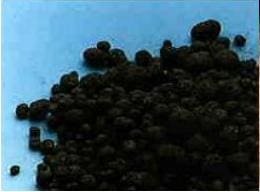
Zinc was being recovered from residual materials, called waste at the time, long before the term recycling came into use. Back at the end of the 19th century, a relatively simple technique was discovered for enriching zinc from ore in a rotary kiln. The method currently known as the Waelz process has been in use for about 50 years to recover zinc from residuals such as steel plant dust. The dust has to be processed with a carbon source to produce a stable granulate, and EIRICH granulating mixers are used worldwide for that purpose. One system for a large producer of high-grade zinc and zinc alloy in Russia is ready for delivery, and engineering work for a second system was completed at the end of 2014.
Worldwide zinc consumption currently exceeds 10 million tonnes. Roughly half of that goes to galvanization of iron and steel products to stop corrosion. Most of the remainder is turned into zinc sheet metal, alloys containing copper (brass), aluminum or magnesium and highgrade zinc cast alloys. Zinc has been used for rust protection on iron and steel products since the 18th century.
When recycled items are melted down at steel plants after many years of use, the zinc is vaporized and deposited in the scrubber filter as zinc oxide. Recycling of zinc from scrap steel is becoming an increasingly viable alternative to extraction of zinc from ore. Substantial amounts of zinc being recycled today are more than 100 years old and were part of roofs or gutters in their previous lives. Recycling currently meets about 30 % of zinc demand.
The Waelz process has been the standard technique for processing zinc-laden dust and sludge for many years. Recycling material containing zinc oxide is fed into rotary kilns up to 50 meters in length, where it remains for 4 – 12 hours. At temperatures up to 1200 °C, the oxide in the material is reduced to zinc which is in the gaseous state under these conditions. The zinc vapor reacts with the oxygen in the kiln atmosphere to form zinc oxide which is captured as dust, as so-called Waelz oxide, and subsequently used in zinc production.
For reduction to take place, the recycling material must be mixed together with a carbon source (e.g. coke) which also acts as an energy source. Granulate must be produced from this mixture.
EIRICH equipment has a proven track record in high-quality mixing and granulation applications for a broad spectrum of consistencies ranging from highly plastic to powdery. Over the past few decades, experience has shown that because EIRICH mixers are capable of producing better and more homogeneous distribution of the reducing agent, dwell time in the kiln can be shorter which in turn boosts production rates. Also, in contrast to other mixers, tool speed can be varied over a wide range allowing users to react to changes in the infeed material, so the systems are future-proof. That is the reason why a recycler in Russia decided in favor of EIRICH processing technology.